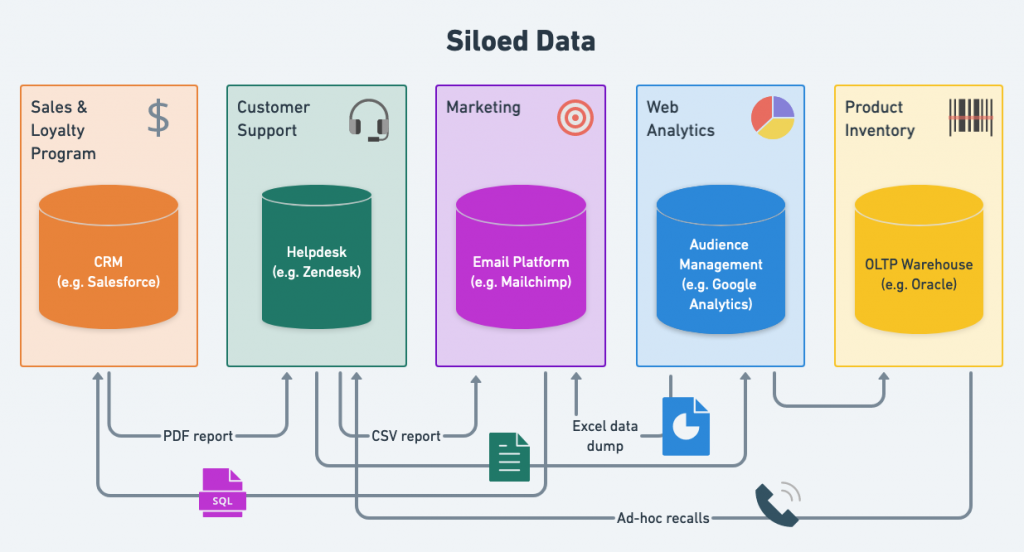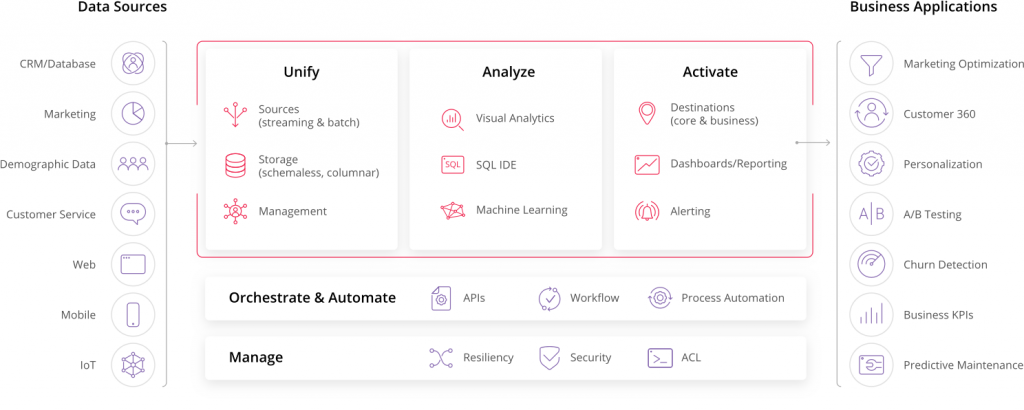
In large organisations, data is often siloed. This means that different teams within the workplace collect, store and utilise their own customer information. We’ll look at some possible solutions to this.
Common challenges in retail data
In large organisations, data is often siloed. This means that different teams within the workplace collect, store and utilise their own customer information. Often this is for good reason, because the data is optimised to suit the tools in use by each, individual team.
It usually looks something like this.

With this type of data management, it’s impossible to get a high-level view of the customer from a total business perspective.
With the data structure as it stands, it poses a number of challenges;
- There is overlapping and redundant data stored by each, separate team. The cost of data storage to the organisation is high when data is siloed in this way.
- The contents of each data silo differs slightly, due to each team setting their structures up differently, e.g. accounting might have different fields for storing customer names than the marketing team. Teams cannot easily determine whose data is most up-to-date and accurate relating to the same customer.
- When teams inevitably need information from each other, manual reports are prepared and shared, which quickly go out-of-date. Generating reports is time-consuming, and reduces the teams capacity to do other, more productive things. It also becomes impossible to tell if the decisions made based on the reports provided are using the most up-to-date data.
Lastly, but most importantly, no one team is looking at the same customer data. Executive teams are unable to make well-informed decisions, because the data they are dealing with is already out-of-date by the time they are reading it.
Get ready to know your customer
To solve these problems, three key strategies have to be employed.
1. Data integration
All the data needs to be in one place. Every first-party customer interaction, on all channels, needs to be brought together.
This means mobile, back-end, web, in-store, payment services, help desks and CRM interactions are all stored together and identifying the customer at every point of interaction.
Importantly, data integrations should also allow data to flow the other way as well – from the centralised data store to the tools the teams use.
2. Data governance
Data needs be reliable, clean and uncorrupted to be of value. Governance is important because it ensures that once data is extracted from the application that collected it, the rules and details of the data are known and respected by all other applications, and by teams that use it.
Good data governance makes data easy to use and share.
3. Audience management
Data needs to actionable once it is collected. AM builds profiles out of the ingested data. It allows specific information about preferences and habits to be drawn from the customer profile. Things like brand loyalties, favourite categories and online log-ins per week should all be accessible to be easily acted upon by interested teams.
Customer Data Platforms
A Customer Data Platform (CDP) is the gold standard tool for integrating, governing and managing data.
With a CDP, the data becomes consistent across all teams, and is of the highest quality, Audience management metrics are driven by complete and accurate data.
The consequence of managing data in this way is that each interaction with your customer can be personalised based on accurate and up-to-date insight.
It looks something like this:

Advanced capabilities unlocked by CDP
Providing unified customer data, enables advanced business capabilities, including:
Improve your user’s experience
Create magic online experiences that encourage customers to stay longer and buy more, backed by accurate feedback from user interactions.
Personalise product recommendations
Know your customer well enough to provide recommendations of your products and services, in line with their needs.
Merchandising
Know how your customers interact with your merchandise and plan your layouts and visual displays accordingly.
Customer loyalty and lifetime value
Know exactly what your customer is worth to your business, how loyal they are to your products and services and what makes them stay.
Online to offline
Follow your customers from online to offline engagement with your business. Know what each customer wants to do online and what they do in-store by connecting their experiences.
A solid data backbone can transform the ability to see deeply into a customer’s wants and needs. It can create magic experiences, where customer’s feelings and desires are easily interpreted and delivered upon.
CDP case studies
All case studies are provided by Deloitte.
Product Recommendation — E-commerce platform, EMEA
A global e-commerce platform wanted to expand its product recommendation capabilities across its many product verticals and [improve their data strategy]. The retailer spent 12-18 months aggregating all customer data across verticals to create a single view of customers’ browsing and purchasing patterns. The retailer ran A/B tests on the customer data and developed an algorithm to drive continuous improvement in recommendation accuracy. This resulted in a 500% increase in sales conversion in some of the retailer’s product lines.
Customer Loyalty and LTV — Multinational supermarket, EMEA
A supermarket with an established loyalty card program wanted to boost its effectiveness in driving long-term customer LTV. To improve its maturity from mature to leading, the retailer incorporated additional metrics into its LTV calculation beyond just spend (e.g., number of categories shopped, number of channels shopped, frequency of visits). The retailer also revamped targeted promotional offerings to personalise every message and offer sent to each customer. Success was measured by the ability to move customers up the LTV curve. By taking this highly personalised approach to customer loyalty, the supermarket increased its bottom line profitability by one percent.
Online to offline — Multichannel furniture store, US
A national furniture retailer found that, while its website attracted a lot of traffic, the majority of its sales happened in-store. The retailer wanted to improve [its data capability] to increase footfall in-store and improve sales conversion rates. The retailer developed a quick response (QR) code model to track customers who move from online browsing to in-store shopping. The QR code offered a prize, which was only redeemable in- store. Customers were directed to the nearest store using location data from when they first scanned the QR code. When the customer then rescanned the QR code in-store, sales assistants could view what they browsed online and show them similar in-store furniture, thereby improving the customer experience.

